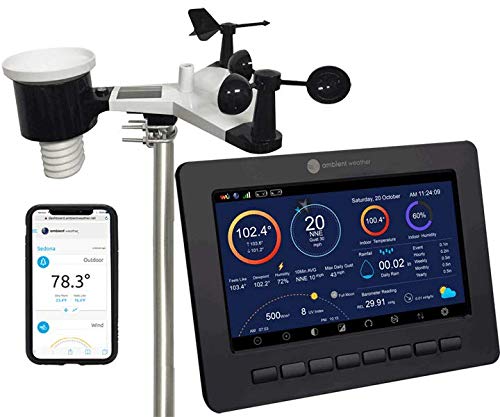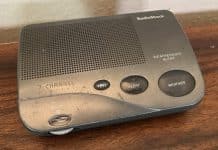Are you a weather enthusiast or simply someone who likes to stay prepared for any weather conditions?
If so, then you’ve come to the right place. In this article, we will explore the question of what is the best weather station for home use.
Whether you’re interested in monitoring temperature, humidity, rainfall, or wind speed, we will provide valuable information and recommendations to help you make an informed decision and find the perfect weather station to meet your needs. Get ready to take your weather tracking to the next level!
Review contents
1. Wireless or Wired?
1.1 Pros and Cons of Wireless Weather Stations
Wireless weather stations offer the convenience of easy installation without the need for complex wiring. They use wireless technology to transmit data from the sensors to the display unit or a connected device.
The main advantage of wireless weather stations is their sensor placement flexibility. You can position the sensors in optimal locations to obtain accurate readings without worrying about connecting them through wires. Wireless weather stations often come with mobile app integration, allowing you to monitor the weather data remotely.
However, there are a few downsides to consider. One potential drawback is the range limitation of wireless weather stations. Depending on the model and the environment, the effective range may vary.
You need to ensure that the sensors are within the range of the display unit or receiver for reliable data transmission. Another consideration is the dependence on batteries to power the sensors. This might require periodic battery changes or recharging, which can be inconvenient.
1.2 Pros and Cons of Wired Weather Stations
Wired weather stations, however, require physical connections between the sensors, the display unit, or a computer. These connections ensure a stable and consistent data transmission.
One of the advantages of wired weather stations is their reliability. Since they do not rely on wireless signals, they are less prone to interference and signal loss. This makes them a suitable option in areas with high electromagnetic activity.
Another benefit of wired weather stations is the absence of battery requirements for the sensors. Unlike their wireless counterparts, wired stations draw power directly from the connection, eliminating the need for battery replacements. Additionally, wired weather stations often have better connectivity options, such as USB or Ethernet, allowing direct data transfer and integration with other devices and software.
However, the installation process for wired weather stations can be more involved, requiring the positioning of sensors and running wires to connect them. This may limit the flexibility in sensor placement and require more effort during setup. Additionally, the physical connections can be vulnerable to damage and require more careful maintenance.
2. Accuracy and Precision
2.1 Importance of Accuracy in Weather Stations
Accurate weather data is crucial for various applications, from personal planning to agricultural operations and scientific research. A high-quality weather station should provide precise measurements that reflect the weather conditions.
Accuracy is critical regarding temperature, humidity, barometric pressure, wind speed, and rainfall data. Reliable and precise measurements allow for better decision-making and more accurate forecasts.
2.2 Factors Affecting Accuracy
Several factors can affect the accuracy of a weather station. The quality of the sensors is one of the primary factors. High-quality sensors with advanced technology tend to provide more accurate and reliable data.
Additionally, the calibration of the sensors is essential. Regular calibration ensures that the readings remain accurate over time.
Environmental factors also play a role in accuracy. The placement of sensors, exposure to direct sunlight, proximity to heat sources, and shelter from rain or debris can impact the readings. Considering these factors and positioning the weather station in an optimal location is essential to minimize potential inaccuracies.
2.3 How to Determine the Accuracy of a Weather Station
To determine the accuracy of a weather station, you can compare its readings to data from a reliable and well-calibrated reference station.
By comparing the measurements, you can identify any potential discrepancies or inaccuracies. It’s also essential to check whether the weather station has undergone any certifications or testing to ensure accuracy.
Manufacturers may provide information regarding the station’s accuracy specifications, such as the margin of error for each sensor.
3. Sensor Types
3.1 Thermometer
The thermometer is one of the fundamental sensors in a weather station. It measures the temperature of the surrounding air. Different types of thermometers are used in weather stations, such as digital thermometers, thermistors, and thermocouples.
Digital thermometers provide quick and accurate temperature readings, while thermistors and thermocouples offer greater precision and sensitivity in extreme temperatures.
3.2 Hygrometer
Hygrometers are sensors that measure humidity levels in the air. They are essential for understanding the moisture content and can be crucial for determining comfort levels, potential mold growth, and even the behavior of certain diseases.
Capacitive hygrometers and thermal hygrometers are commonly used in weather stations. Capacitive hygrometers measure humidity using changes in electrical capacitance, while thermal hygrometers rely on the effects of temperature on a sensing element.
3.3 Barometer
Barometers measure atmospheric pressure, providing valuable information for weather forecasting and analysis. Weather stations typically use barometric pressure sensors, such as mercury barometers, aneroid barometers, or electronic barometers.
Electronic barometers are more common in weather stations due to their compact size, durability, and accuracy. They utilize electronic components to measure pressure variations.
3.4 Anemometer
Anemometers measure wind speed and are essential for understanding weather patterns and predicting severe weather conditions. Weather stations commonly use cup anemometers, propeller anemometers, and sonic anemometers.
Cup anemometers have rotating cups that measure wind speed based on the rotation rate. Propeller anemometers use a propeller that rotates with the wind, and sonic anemometers utilize ultrasonic technology to measure wind speed and direction.
3.5 Rain Gauge
Rain gauges measure the amount of precipitation, providing crucial data for tracking rainfall patterns and predicting floods. The most common type of rain gauge used in weather stations is the tipping bucket rain gauge.
It consists of a collection funnel and a mechanism that tips when a predefined amount of water is collected. This tipping motion indicates the quantity of rainfall.
3.6 UV Sensor
UV sensors measure the intensity of ultraviolet radiation from the sun. These sensors help determine the UV index, which indicates the potential sunburn risk and the need for appropriate sun protection. UV sensors can be crucial for monitoring outdoor activities and maintaining optimal UV exposure for health and safety.
3.7 Solar Radiation Sensor
Solar radiation sensors measure the amount of solar energy or sunlight reaching the earth’s surface. These sensors provide valuable information for solar energy systems, agriculture, and scientific research. Pyranometers and pyrheliometers are commonly used solar radiation sensors in weather stations. Pyranometers measure the total solar radiation, while pyrheliometers precisely measure direct solar radiation.
4. Ease of Installation and Use
4.1 Mounting Options
Weather stations offer various mounting options to suit different needs and locations. The most common mounting options include pole mount, wall mount, and tripod mount. Pole mounts provide stability and a higher vantage point for reliable measurements. Wall mounts are suitable for stationary installations on a building or structure, while tripod mounts offer portability and flexibility in sensor placement.
4.2 User-Friendly Interface
A user-friendly interface is crucial for easy operation and data interpretation. Weather stations with intuitive displays, clear labels, and easy navigation make accessing and understanding the weather data simple. LCD screens with backlighting or touchscreen capabilities enhance the user experience, allowing for effortless interaction with the station.
4.3 Setup and Calibration
The setup process for a weather station should be straightforward and well-documented. Clear instructions and labeled components make it easy for users to assemble and install the station.
Additionally, regular calibration is essential to maintain accuracy. Some weather stations offer self-calibration features or automated calibration reminders, simplifying the calibration process for users.
5. Connectivity Options
5.1 Local Display and Data Storage
Local display and data storage options provide immediate access to weather data without relying on external devices. Weather stations with built-in displays allow users to monitor real-time measurements directly from the console.
Moreover, stations with ample data storage capacity enable users to analyze historical weather patterns for long-term planning and analysis.
5.2 Internet Connectivity
Internet connectivity is a valuable feature for remote monitoring and sharing weather data. Weather stations with internet connectivity can transmit real-time data to online platforms, allowing users to access and share information from anywhere with an internet connection.
This feature is handy for weather enthusiasts, researchers, and individuals interested in weather conditions.
5.3 Mobile App Integration
Mobile app integration enables users to access weather data conveniently through their smartphones or tablets. Weather stations that offer dedicated mobile apps allow users to monitor real-time data, receive customized alerts, and access historical data on the go. Mobile app integration enhances the user experience and provides seamless access to weather information anytime, anywhere.
6. Power Source
6.1 Battery-Powered Stations
Battery-powered weather stations offer flexibility in terms of installation and portability. They do not require direct power connections, making them suitable for remote or temporary installations. However, it’s essential to consider the battery life and potential replacement costs when opting for a battery-powered station. Regular battery maintenance and replacements may be necessary depending on the station’s power consumption and the type of batteries used.
6.2 Solar-Powered Stations
Solar-powered weather stations utilize solar panels to convert sunlight into electrical energy. This renewable energy source allows for continuous operation without needing battery replacements or external power connections. Solar-powered stations are eco-friendly and can provide long-term cost savings. However, their reliability depends on the availability of sufficient sunlight and the efficiency of the solar panels.
7. Additional Features
7.1 Weather Forecasting
Some weather stations come equipped with weather forecasting capabilities. These stations analyze the collected data and provide short-term and long-term weather forecasts. Weather forecasting features allow users to plan outdoor activities, prepare for weather changes, and stay informed about future weather conditions.
7.2 Historical Data Analysis
Analyzing historical weather data is valuable for understanding climate patterns and trends. Weather stations that offer data logging and analysis features enable users to review past measurements, identify patterns, and make informed decisions based on historical weather data. This feature is handy for researchers, gardeners, and individuals interested in monitoring long-term weather changes.
7.3 Compatibility with Smart Home Systems
Smart home integration allows weather stations to connect with other smart devices and systems within a home network. A weather station compatible with smart home systems can provide seamless integration with voice assistants, smart thermostats, irrigation systems, and other IoT devices. This integration enables users to automate specific actions based on the weather conditions, enhancing overall convenience and energy efficiency.
8. Budget Considerations
8.1 Price Range
Weather stations come in various prices, depending on the features, sensor accuracy, and connectivity options. Establishing a budget range based on your requirements and priorities is important. Consider the desired features, durability, and long-term value when determining the appropriate price range for your weather station.
8.2 Value for Money
When evaluating the price of a weather station, consider its overall value for money. Look for a balance between the price and the features, accuracy, durability, and customer support offered by the manufacturer. Reading customer reviews and comparing different models can help you assess the value proposition of each weather station.
9. Customer Reviews and Ratings
9.1 Research and Read Reviews
Before purchasing a weather station, take the time to research and read customer reviews. Customer reviews provide valuable insights into different weather stations’ performance, reliability, and user experience. Pay attention to reviews from verified buyers and seek consensus on the key features and performance aspects that matter to you.
9.2 Consider User Feedback and Ratings
Consider both positive and negative feedback from users to better understand the weather station’s strengths and weaknesses. Look for common themes in the feedback and evaluate how those factors align with your requirements. Additionally, consider the overall ratings and reputations of the products and manufacturers to make an informed decision.
10. Warranty and Support
10.1 Length and Coverage of Warranty
When purchasing a weather station, consider the length and coverage of the warranty the manufacturer provides.
A more extended warranty period indicates the manufacturer’s confidence in the product’s quality and reliability. Look for warranties that cover both parts and labor to ensure comprehensive protection.
10.2 Customer Support Availability and Responsiveness
Reliable customer support is crucial for addressing any issues or concerns that may arise during the setup or operation of the weather station.
Check the manufacturer’s reputation for customer support and availability to assist with troubleshooting or technical questions. Prompt and responsive customer support can provide peace of mind and ensure a smooth experience with your weather station.
In conclusion, choosing the best weather station for home use requires considering various factors such as wireless or wired options, accuracy and precision, sensor types, ease of installation and use, connectivity options, power source, additional features, budget considerations, customer reviews, and ratings, as well as warranty and support.
By evaluating these aspects based on your specific needs and preferences, you can select a weather station that provides reliable and accurate weather data to meet your requirements.








































